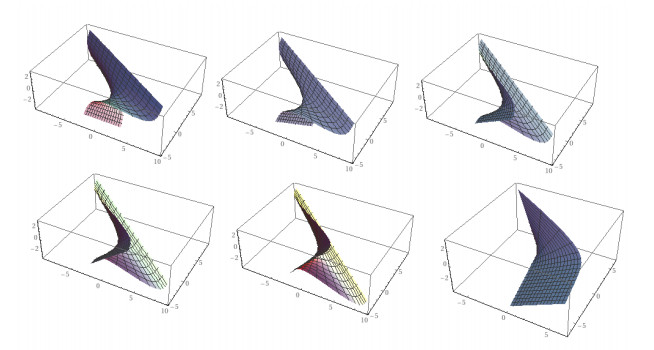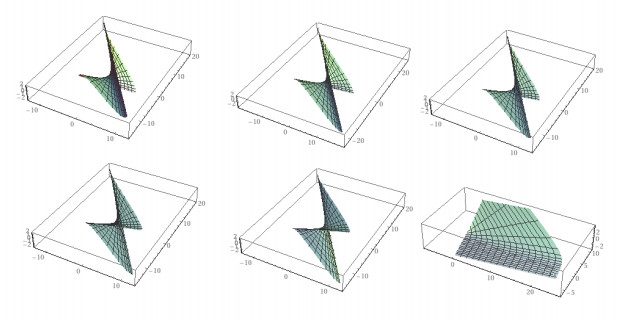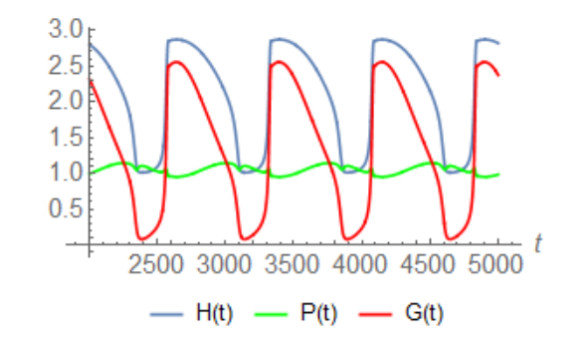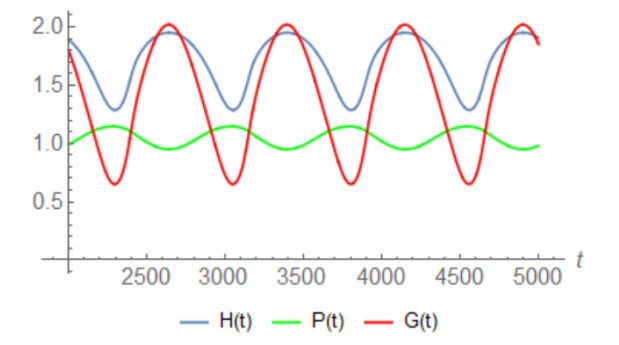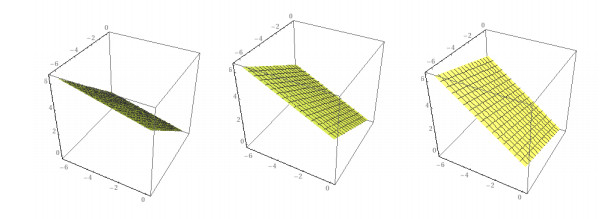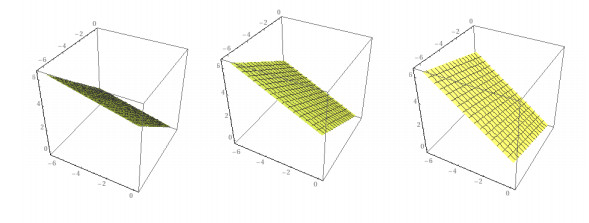1.
Introduction
The mathematical modeling system of VBD (discreet formula as well as the continuous type) is presented by many researchers depending on the developments of VBD [1]. Dye [2] suggested the simple population system by the formula
where P(τ),P(⊤+τ) indicate the population magnitudes in straight groups, and ρ is the finite rate of growth (net fertility after lifetime density autonomous humanities). For ϱ is water containers, and γ is the upper slope of the association between humanity and log population magnitude. May [3] formulated the following model
Then Bellows [4] presented the design
Recently, systems (1)–(3) are generalized into 2D-systems called the parasitoid-host system (PHS) [5]
where
● H,P are the population densities for host and parasitoid accordingly;
● F:R+×R+→R+ takes one of the formulas in (1)–(3) and it indicates the fraction of host population that does not para-sized (infected). Special forms are given as follows: F(P(τ),H(τ))=exp(−ϱPγ) and F(P(τ),H(τ))=(1+ϱP(τ))−γ. Note that when γ=1, we have the logistic function F(P(τ),H(τ))=(1+ϱP(τ))−1. Moreover, it can be formulated by F(P(τ),H(τ))=exp(−ϱPτ) (see [5]). In our study, we suggest the Hyperbolic tangent, which is the shifted and scaled type of the logistic function F(P(τ),H(τ))=tanh(P(τ)). This function is listed as an activation function as well as a Sigmoid function (utility function). As an application, it can be utilized in the field of artificial intelligence, especially the artificial neural network [6,7].
● ρ1 represents the size of the growth of the host;
● ρ2 is the rate of a parasitoid population;
● τ,⊤ is the recent time and its iteration respectively.
Different studies are considered for system (4) by researchers and investigators. Din [8] adapted the PHS with the application of constant retreat effects and described global dynamics for the projected model. In [9], the authors reformed the PHS with a growth function for the host population and considered Neimark-Sacker bifurcation and chaos control. In [10], global stability and Hopf bifurcation approved a class of PHS.
We proceed to define the third dimension of our system. We suggest including an environment factor called parasitic transmission media (PTM), which includes all types of garbage, water, food, and air. Human health is at hazard through our indecision. We keep creating large amounts of garbage, we do not place of it properly, and in the end that will be our breakdown as it is for the environment and nature in the bionetworks we all stake. We cannot avoid or promote longevity with how we delight our Earth. The more emissions that we create due to how much trash we produce, affects us long term. One can progress diseases such as asthma, birth defects, cancer, cardiovascular disease, childhood cancer, COPD, infectious diseases, low birth weight, and preterm delivery. Bacteria, vermin and insects can also be recognized to the problem that garbage effects.
The dynamic variable G(τ) defines the mass of PTM in a specific PTM grip at time τ where 0≤τ≤24 and ⊤∈R. As the system profits day-to-day garbage gathering, the time scale of deliberation will be 24 hours and the unit of time utilized will be "hours". The mass of PTM G(τ) will be sized depending on its type. It is presumed that between time τ and ⊤+τ, a total of H(τ) number of persons credit the PTM in the grip. The number of active garbage removal units at time τ is given by P(τ), the amount of PTM left in the hold under the effect of these two functions is given by the chaotic equation [11]
where α1 is the mass of PTM given per person per unit time, α2 is the mass of PTM removed by removal unit per unit time. Here, we define the chaotic formula of (5) as follows:
where α0>0 indicates the cumulative mass and α∈[0,1]. Combining 2D-System (4) and and Eq (6) to obtain the following 3D-discrete dynamic system
The remaining study in this paper is that the permanence of outcomes of Model (7) is reflected. Global stability investigations of the set of fixed points of Model (7) are considered. The control strategy is established for controlling the chaotic and fluctuating condition of Model (7) about its fixed points. In the end, numerical simulations are given to confirm the mathematical investigations.
2.
Illustrated systems
In this part, we illustrate a set of systems that are relevant to System (7). In the sequel, we deal with the following structure.
For special case, we assume that F(Pn,Hn)=tanh(Pn), (see Figure 1) we have the following system
We note that tanh(.) is an activation function that income, we can catch the slope of the sigmoid arc at every two points. Production values are bound between zero and one (during the first epoch of training), normalizing the output of every point. Also, the activation function tanh has a symmetric value [-1, 1]; henceforth, it types the strata lying to quicker saturation.
Moreover, one can generalize Model (9), by using the difference operator
to formulate the model
This implies the model
Finally, the continuous model with respect to time t is formulated as follows:
The Jacobian matrix of Model (11) is given by
where
Thus, we have
The set of eigenvalues of J is
Model (11) has the following set of fixed points satisfying Hn+1=Hn,Pn+1=Pn,Gn+1=Gn
where ℓ:=log(√ρ1+1ρ1−1) providing that ρ1≠1,α0≠1 and ρ2≠0. Hence, for α0=2, we get the following cases of the set of the eigenvalues
●
which dominated an attracting saddle. This surface has an unstable eigenvalue generating one direction of outflow behavior and two stable eigenvalues generate a plane involving all the inflow streamlines (see Figures 2–4);
● assuming α=0, we obtain φ1(ℓ(♭,1,−1)), where ♭:=ρ1ρ2(ρ1−1) then
● when α=1, we have φ1(ℓ(♭,1,♭)), which implies the same eigenvalues in Λφ1, where α=0 and α=1 are the end points of the chaotic Model (11).
● If ρ1=ρ2≠1, then we have ♭=1/(1−ρ1) and
Note that the zeros of √850♭2+4974♭+2719 are ♭1=−0.6 and ♭2=−5.24. This leads to the approximated values of λ2,3≈0.00636 and λ2,3≈1.0405 respectively, when ρ1=2. More approximation yields
and
● The set of equilibrium points is as follows:
Consequently, we have
with the following set of eigenvalues
which is equal to the set Λφ0 when α0=2. Model (11) has a saddle surface (see Figures 2–4 for the generation of the point), which satisfies the max-min inequality
Moreover, Model (9) is permanent if the inequality holds:
where S={(HN,Pn,Gn)} is a positive solution for Model (9).
Since complex behavior means that small changes to parameters or initial conditions can have large effect on the biological system in long term, therefore, the reconstruction of the system offers (chaotic system) an important tool to study the vector field and the biological dynamics.
3.
Chaotic system
Chaos is a corporate factor that can exist in dynamical systems (discrete and continuous). Due to its properties, it has several applications (see [12,13,14,15]). Numerous indications represent that numerous biological models, particularly the human brain, perform in both chaotic and periodic styles. Researchers presented that the brain's utility permanently changes between various conditions. These interchanges are because of irregularity or illnesses. Given that a beneficial instrument for scrutinizing and improved considering of biological models, chaotic models have recurrently utilized in investigative studies to analyze and formulate biological models (see [16,17,18]). The result curves to chaotic systems commonly show fractal construction. The construction of the bizarre attractions for general n-dimensional systems might be convoluted and problematic to detect evidently. The subsequent appearances are approximately permanently showed by the resolutions of chaotic systems (see Figures 5–7):
● Long-term episodic (non- episodic) conduct: the difficulty to realize the difference between episodic and non- episodic conduct.
● Sympathy to initial conditions: depending on initial conditions.
● Fractal construction: the outcome plots to chaotic systems normally show a fractal structure
Theorem 1. Suppose that S={(Hn,Pn,Gn)} is a positive solution for Model (9). If ρ1>1,ρ2∈(0,ρ1] and α0∈(0,1) then Model (9) is permanent. Moreover, the model has a saddle surface.
Proof. From Model (9), we have
By the assumptions, we conclude
Hence, we have
Moreover, a conclusion implies that
Consuming μ1=1 and μ2=ρ11−α0 which leads that Model (9) is a permanent system achieving
Continue the second part, as follows:
where U=V=R+. Thus, the model has a saddle surface.
Remark 1. Model (9) satisfies the chaos in the third equation for α0→0 such that
And when α0→1, we get the chaos difference system
corresponding to the linear model
and to the optimal model, when tanh(P)≈1
3.1. Chaos control of model (11)
Model (11) can be controlled by 2D-controller law as follows:
The third equation can be controlled by suggesting values of α and α0∈(0,1). Figures 6 and 7 showed that the optimal interval for α0∈(0,0.5) and α∈(0,0.4).
We have the following result
Theorem 2. The Model (11) can be controlled by 2D-controller (17).
Proof. The controlled model can be recognized as follows:
Substituting (17) in (19), we obtain
In matrix form, we have
The goal is to prove that the zero equilibrium of (20) is asymptotically stable, which indicates that the model states converge towards zero as time progresses. Since all the eigenvalues λ1,2=−1,λ3=−(1−α0),α0∈(0,1) of the model are negative; then by the stability theorem, we have that the zero outcomes is asymptotically stable and, thus the system is stabilized.
3.2. Discrete Lyapunov formula (DLF)
The DLF is given by the structure
where Θ is a Hermitian matrix and Σc is the conjugate transpose of Σ. It is well known that for Θ>0 there exists a unique Δ>0 such that Σ⊤ΔΣ−Δ+Θ=0 if and only if the model is asymptotically stable. In view of Theorem 2, the Model (11) is asymptotically stable for α∈(0,1),α0∈(0,1), which leads to satisfy the DLF, where χ⊤Δχ is the Lyapunov formula. Next example shows the DLF for Model (21) with different parameters (see Figure 8).
Example 1. Let the following data hold
● α=0.25,α0=0.75 then DLF is
where the solution is (0.24660.010.0989);
● α=α0=0.5 the DLF is given by
for the solution (0.60.050.001).
● α=0.75,α0=0.25, then
where the solution is (0.90.150.01);
● α=0.75,α0=0.25 then
with the solution (10.250.02);
● α=0.75,α0=0 then, we get
satisfying the solution (10.250.021).
● α=0.34,α0=0.45, then DLF is
having the outcome (21.250.2).
Note that, the last solution is controlled by the hosted and decreases the parasitiod providing ρ1=ρ2 (see Figure 9).
4.
Discussions
The Model (21) achieves
and all the matrices in the above example satisfy Rank<3. The low-rank DLFs is of pronounced significance, where normally hard to calculate in control system investigation and strategy. Opportunely, Mesbahi and Papavassilopoulos [19] presented that under some conditions, the lowest-rank results of the DLF can be professionally solved by linear programming.
In [20], the authors proved that the lowest-rank results of both the continuous and discrete Lyapunov formulas over symmetric shape (like tanh function) are unique and can be precisely resolved by their convex relaxations and the symmetric linear programming issues. Proposition 4.4 in [20] indicated that the unique outcome could select an exact lowest-rank solution to DLF over the symmetric shape to its trace minimization relaxation issue. Therefore, all solutions in Example 1 are unique for a set of parameters.
5.
Conclusions
A 3D-mathematical model for the Vector-Borne Disease is formulated. The design assumes three sub-populations: the human population (H), the vector population (P) and the parasitic transmission media (G). The design equilibrium explanations were indicated, and the environments for their stability were recognized. A numerical solution to the model was recognized utilizing the discrete Lyapunov formulas were simulated for different values of parameters of the disease situation, Figures 5–8. Our simulations show that control actions, which minimize the population rank, the human-vector transmission rate as well as vector-human transmission media (such as garbage collection and removal, dirty food, body-liquids or substances, by airborne breath). Hence, control processes that address these fixed factorize (disease transmission parameters) would be valuable in the attempt towards the annihilation of the infection.
Conflict of interest
The author declares that there is no competing interests.
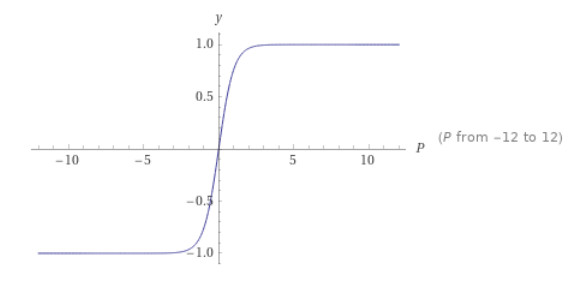









 DownLoad:
DownLoad:

